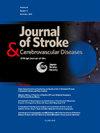Quality indicators of stroke care in Colombia based on the RES-Q registry
IF 2
4区 医学
Q3 NEUROSCIENCES
Journal of Stroke & Cerebrovascular Diseases
Pub Date : 2025-02-06
DOI:10.1016/j.jstrokecerebrovasdis.2025.108249
引用次数: 0
Abstract
Objectives
This study seeks to outline the epidemiological patterns and quality of care indicators of ischemic stroke in Colombia. It serves as a pioneering effort, offering crucial national-level insights to inform evidence-based stroke policies in Colombia.
Materials and Methods
Using data from the Registry of Stroke Care-Quality (RES-Q) spanning the years 2017 to 2021, a multicenter descriptive study was conducted in Colombia. A survival analysis using Kaplan-Meier curves was planned for the time from symptom onset to hospital arrival, hospital stay and mortality, stratified by pre-established geographic regions.
Results
A total of 7,963 patients were included in 4 geographic regions: Amazon, Andean, Caribbean and Pacific. The main data provider was the Andean region with 6,402 patients (80.3 %). 49 % were women. The median age was 72 years (IQR 61-81). The NIHSS scale was a median of 7 IQR (3-15). 14.5 % (994) received intravenous thrombolysis therapy. The door to needle time was 53 min IQR (36-70). 53 % were hospitalized in a standard bed, 41 % in intensive care/stroke unit. 33.4 % patients had a Rankin score at discharge between 0-2.
Conclusion
First study conducted using RES-Q data at the national level in Colombia. A reduction of door-to-needle times by at least 50 % compared to historical levels is evident. Low reperfusion rates persist. Secondary prevention measures are needed with the implementation of national stroke policies.
基于RES-Q登记的哥伦比亚卒中护理质量指标。
目的:本研究旨在概述哥伦比亚缺血性中风的流行病学模式和护理质量指标。它是一项开创性的工作,为哥伦比亚基于证据的中风政策提供了重要的国家级见解。材料和方法:使用卒中护理质量登记处(RES-Q) 2017年至2021年的数据,在哥伦比亚进行了一项多中心描述性研究。计划使用Kaplan-Meier曲线对从症状出现到住院、住院和死亡率的时间进行生存分析,并按预先建立的地理区域分层。结果:共有7,963例患者被纳入4个地理区域:亚马逊、安第斯、加勒比海和太平洋。主要数据提供者是安第斯地区,有6402例患者(80.3%)。49%是女性。中位年龄为72岁(IQR 61-81)。NIHSS量表中位数为7 IQR(3-15)。14.5%(994例)接受静脉溶栓治疗。开门至穿刺时间53分钟IQR(36-70)。53%的患者住标准床,41%住重症监护/中风病房。33.4%的患者出院时Rankin评分在0-2之间。结论:首次在哥伦比亚国家一级使用RES-Q数据进行研究。与历史水平相比,从门到针的时间明显减少了至少50%。低再灌注率持续存在。随着国家脑卒中政策的实施,需要采取二级预防措施。
本文章由计算机程序翻译,如有差异,请以英文原文为准。
求助全文
约1分钟内获得全文
求助全文
来源期刊

Journal of Stroke & Cerebrovascular Diseases
Medicine-Surgery
CiteScore
5.00
自引率
4.00%
发文量
583
审稿时长
62 days
期刊介绍:
The Journal of Stroke & Cerebrovascular Diseases publishes original papers on basic and clinical science related to the fields of stroke and cerebrovascular diseases. The Journal also features review articles, controversies, methods and technical notes, selected case reports and other original articles of special nature. Its editorial mission is to focus on prevention and repair of cerebrovascular disease. Clinical papers emphasize medical and surgical aspects of stroke, clinical trials and design, epidemiology, stroke care delivery systems and outcomes, imaging sciences and rehabilitation of stroke. The Journal will be of special interest to specialists involved in caring for patients with cerebrovascular disease, including neurologists, neurosurgeons and cardiologists.
 求助内容:
求助内容: 应助结果提醒方式:
应助结果提醒方式:


